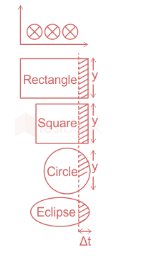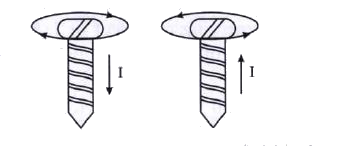Table of Contents
Ans. (b) the circular and elliptical loops
Explanation:
Consider a rectangular, a square, a circular, and an elliptical loop moving perpendicularly out from a magnetic field B with constant velocity

From the given figure:
Ans. (a) largely increases
Explanation: The magnetic field inside the solenoid increases due to the high permeability of the ferromagnetic material.
Explanation:
(i) Here \text{A = πa}^2 , θ = 0°. So flux linked with the loop is
Induced current,
\\ I =\dfrac{\text { Inducede. } m . f .}{\text { resis } \tan c e}=\dfrac{e}{R} \\[4.5 bp]
=-\dfrac{d \phi / d t}{R}=\dfrac{-1}{R} \dfrac{d}{d t}\left(B A \cos 0^{\circ}\right) \\[4.5 bp]
I =-\dfrac{A}{R} \dfrac{d}{d t}\left(B_{0} \sin \omega t\right)=-\dfrac{A B_{0}}{R} \cos \omega t(\omega) \\[4.5 bp]
I =\dfrac{\pi a^{2} B_{0} \omega \cos \omega t}{R}
Explanation:
If the forward motion of a right handed imaginary conductive screw is in the direction of the current through a linear conductor, then the direction of rotation of the screw gives the direction of the magnetic lines of force around the conductor.

Explanation:
When current was allowed to flow in a wire placed parallel to the axis of a magnetic needle kept directly below the wire, the needle was found to deflect from its normal position.
When current was reversed through the wire, the needle was found to deflect in the opposite direction to the earlier case.
| Chapter No. | Chapter Name |
|---|---|
| Chapter 1 | Electric Charges and Fields |
| Chapter 2 | Electrostatic Potential and Capacitance |
| Chapter 3 | Current Electricity |
| Chapter 4 | Moving Charges and Magnetism |
| Chapter 5 | Magnetism and Matter |
| Chapter 6 | Electromagnetic Induction |
| Chapter 7 | Alternating current |
| Chapter 8 | Electromagnetic Waves |
| Chapter 9 | Ray Optics and Optical Instruments |
| Chapter 10 | Wave Optics |
| Chapter 11 | Dual Nature of Radiation and Matter |
| Chapter 12 | Atoms |
| Chapter 13 | Nuclei |
| Chapter 14 | Semiconductor Electronics: Materials, Devices and Simple Circuits |
| Chapter Wise Important Questions for CBSE Board Class 12 Physics |
|---|
| Electric Charges and Fields |
| Electrostatic Potential and Capacitance |
| Current Electricity |
| Moving Charges and Magnetism |
| Magnetism and Matter |
| Electromagnetic Induction |
| Alternating current |
| Electromagnetic Waves |
| Ray Optics and Optical Instruments |
| Wave Optics |
| Dual Nature of Radiation and Matter |
| Atoms |
| Nuclei |
| Semiconductor Electronics: Materials, Devices and Simple Circuits |
CBSE Important Questions Class 10
ICSE Important Questions Class 10
CBSE Important Questions Class 10
ICSE Important Questions Class 10